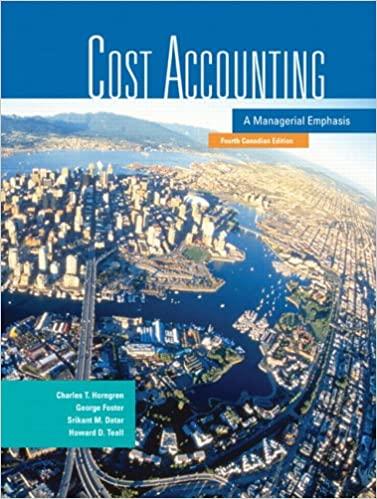Product costs, activity-based costing systems. Executive Power (EP) manufactures and sells computers and computer peripherals to several
Question:
Product costs, activity-based costing systems. Executive Power (EP) manufactures and sells computers and computer peripherals to several nationwide retail chains. Johan Farnham is the manager of the printer division. Its two largest selling printers are P-41 and P-63.
The manufacturing cost of each printer is calculated using EP’s activity-based costing system. EP has one direct manufacturing cost category (direct materials) and the following five indirect manufacturing cost pools:
Indirect Manufacturing Allocation Allocation Cost Pool Base Rate 1. Materials-handling 2. Assembly management 3. Machine insertion of parts 4. Manual insertion of parts 5. Quality testing Number of parts Hours of assembly time Number of machineinserted parts Number of manually inserted parts Hours of quality testing time
$1.44 per part
$48 per hour of assembly time
$0.84 per machine-inserted part
$2.52 per manually inserted part
$30 per testing-hour Product characteristics of P-41 and P-63 are as follows:
P-41 P-63 Direct materials costs $489.00 $350.52 Number of parts 85 parts 46 parts Hours of assembly time 3.2 hours 1.9 hours Number of machine-inserted parts 49 parts 31 parts Number of manually inserted parts 36 parts 15 parts Hours of quality testing 1.4 hours 1.1 hours 504 CHAPTER 12 Required What is the manufacturing cost of P-41? of P-63?
Excel Application For students who wish to practise their spreadsheet skills, the following is a step-by-step approach to creating an Excel spreadsheet to work this problem.
Step-by-Step 1. Open a new spreadsheet. At the top, create an “Original Data” section for the data provided by Executive Power. Create rows for the indirect manufacturing cost pools of “Materials Handling, Assembly Management, Machine Insertion of Parts, Manual Insertion of Parts, and Quality Testing,” and create a column for “Allocation Rate.”
2. Skip two rows and enter the data on product characteristics by creating columns for each of the products (P-41) and P-63) and rows for “Direct Materials Costs, Number of Parts, Hours of Assembly Time, Number of Machine-Inserted Parts, Number of Manually Inserted Parts, and Hours of Quality Testing.”
(Program your spreadsheet to perform all necessary calculations. Do not “hard-code” any amounts, such as materials-handling cost, requiring addition, subtraction, multiplication, or division operations.)
3. Skip two rows and create a “Manufacturing Cost Calculations” section. Create columns for each of the products (P-41 and P-63) and rows for each of the cost categories includ¬
ing: “Direct Materials, Materials Handling, Assembly Management, Machine Insertion of Parts, Manual Insertion of Parts, and Quality Testing.” Enter calculations for these costs using data from the Original Data section.
4. Include calculations for total indirect manufacturing product costs (that is, excluding direct materials costs) and total manufacturing product costs on separate rows in this section.
5. Verify the accuracy ofyourspreadsheet. Go to your Original Data section and change the allo¬
cation rate for the materials-handling cost pool from $1.44 to $1.80 per part. If you pro¬
grammed your spreadsheet correctly, total manufacturing product costs for P-41 should change to $969.48.
Step by Step Answer:

Cost Accounting A Managerial Emphasis
ISBN: 9780131971905
4th Canadian Edition
Authors: Charles T. Horngren, George Foster, Srikant M. Datar, Howard D. Teall





